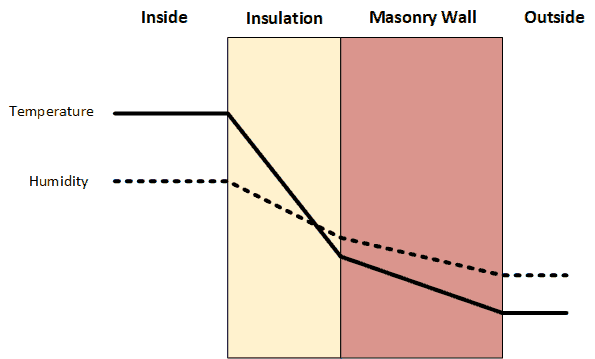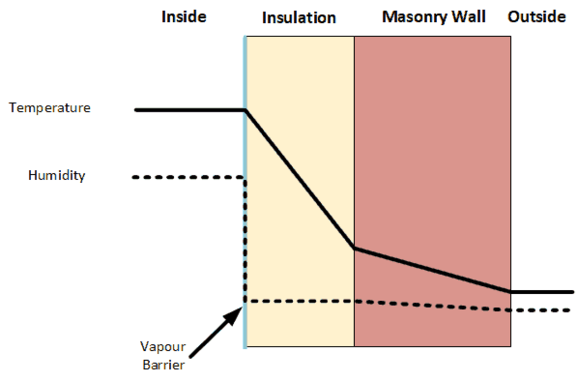Insulation and Condensation
In our eagerness to slap up insulation everywhere, the potential problem of condensation is sometimes overlooked. Air can hold a certain amount of water vapour, and the higher its temperature, the more vapour it can contain. Air in houses in winter often contains more moisture (from breathing, washing, cooking, etc) than the cold air outside can hold.
Thus, if you insulate a surface but do nothing to stop vapour penetration (and things like plaster, wood, brick, concrete, mineral wool, and even expanded polystyrene allow vapour to penetrate easily), you may get a problem. This is what happens:
All the time the humidity line is below the temperature line (this represents less than 100% relative humidity - i.e. humidity relative to the maximum amount of water vapour the air can hold at a particular temperature) the moisture in the air will stay absorbed in the air. Once the humidity rises to over 100%, the moisture will precipitate out as condensation.
The above shows a cross section through an insulated wall, with temperature and absolute humidity graphs superimposed. The temperature and humidity each side of the wall are those of the atmosphere on each side.
The insulation retards heat transfer better than the wall behind, so the temperature drops much more quickly within the insulation than within the wall. However, the insulation and the wall are almost equally vapour permeable, so the absolute humidity drops linearly. At the point the two lines cross - at this point in the insulation the air gets too cold to support the amount of moisture it is carrying. In other words, the dew point (100% relative humidity) has been reached, and condensation will occur. At this position it is known as interstitial condensation, and will saturate the insulation, rendering it less effective. More seriously, it may cause rot in any supporting timbers. It is particularly bad in this location because there is no ventilation to remove it quickly when conditions are more favourable (less absolute humidity and/or higher outside temperature.)
The Solution
The solution is to put in a vapour barrier, like polythene sheet or a foil backing to plasterboard, an the warm side of the wall to alter the profile of the vapour concentration through the wall. You will then get something like this:
The step change in humidity caused by the vapour barrier has made sure that the relative humidity is well below 100% throughout the wall. The vapour barrier is not assumed to be perfect (it will have joins, nail holes, etc), so the absolute humidity just behind the vapour barrier is still a little higher than outside, but an imperfect vapour barrier is usually good enough in most circumstances.
Note that the position of the vapour barrier is very important: it has to be on the warm side of the major insulating element. If it is on the cold side, it will make matters worse by maintaining higher humidity through the insulation.
As has been mentioned, the problem of condensation is worse if there isn't good ventilation to blow away the vapour when conditions allow it to evaporate, such as in insulated walls, where a vapour barrier is essential. However, you can usually get away with insulating the floor of the loft if there is good eaves ventilation and the insulation is baked regularly when the sun shines. But if the loft is boarded, any condensation will take much longer to evaporate. It is thus a good idea to place a vapour barrier underneath loft insulation in these circumstances, especially over humid areas such as bathrooms. Foil backed plasterboard is ideal, but strips of polythene between the rafters will do some good. Don't loop it over the rafters or it will be on the cold side of the insulation at some points. If the loft becomes a heated habitable room, the problem is transferred to the insulation above, because that is where the temperature gradient occurs. For the same reason, condensation between floors isn't usually a problem, and it is rare to have air bricks to allow ventilation. (Air bricks below ground floor level are to allow damp rising from the ground, as well as humidity from above, to be dispersed.)

